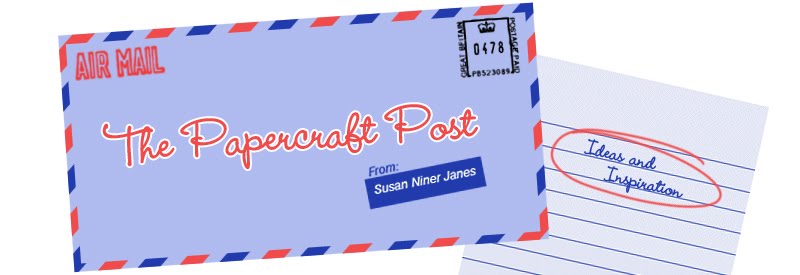 |
| Three tiers of storage to slide outwards or stack upright. |
 |
| A tray on the bottom, matchbox middle tier, and cigar box top layer. |
Today I am beginning a new strand: Papercraft Fabrications. Here I will feature papercraft projects and techniques inspired by textiles, sewing, and needlecraft. This first project is perfectly timed to coincide with National Sewing Month - be prepared!
I recently watched and enjoyed Le Havre, the arthouse feelgood movie. The art direction was tops – and the mood was 50’s retro. My favourite prop was... a cantilever sewing box, prominently displayed. This made me very happy, since I had already designed today’s papercraft project.
Cantilever sewing boxes are minor miracles of engineering. The swivel action provides the wow factor. Basically, they are a set of boxes linked together with movable struts. They are not difficult to make. You just need to take it slow and easy when assembling .
My papercrafted cantilever sewing boxes are mini versions, measuring 10cm wide x 6cm wide x 6cm high (4in x 2-1/4in x 2-1/4in). Filled with buttons, bows, and ribbons they would make memorable gifts for sewing enthusiasts!
The cantilever sewing box consists of a base tray and two levels of boxes. The middle level boxes have matchbox-style drawers. The top level boxes open cigarbox style. The handle is attached to the base tray – it doubles as a divider.
To make a cantilever sewing box, you need: 3 sheets of Craft Creations
Dark Brown Kraft Paper (12in x 12in), 1 sheet of Bazill Basics (for the handle and struts), 30 mini brads, craft thread; double-sided tape, tacky glue. Tools: 1/16" circle hole punch; embossing stylus, small metal ruler.
Here are the pattern templates:
... and here's how to make the cantilever sewing box:
1) This shows the pieces for the base layer. Cut them out and score the folds with an embossing tool held against a small metal ruler. Crease the folds.
2) Tape the tray tabs on the right side of the paper. Join the handle tabs to the handle body and apply tape to the inside as shown.
3) On the left, you can see a completed base layer. Right shows tray with sides joined. Tape or glue the margins to the inside of the tray. Adhere the handle to the tray base. Note: the tray side tabs will obscure some of the holes, so re-pierce them with a hole punch or pointy tool (the tip of a brad works fine).
4) Middle level. Pic shows scored pattern pieces. The lefthand piece makes a slipcase for the drawer (on the right). A reinforcement piece (in brown) has been glued onto the inside of the slipcase. The two projections are glued or taped upwards to strengthen the top and bottom of the slipcase.
5) Assemble the slipcase and drawer as shown. A brad with a brad mat for the drawer pull. Make two slipcases and two drawers. If you wish, you can line the drawer base with either matching or contrast paper.
6) Top level. Make two cigar boxes. The cigar box is made of a lid, which is made separately (left) and a drawer (right). Apply tape as shown. To make the lid, fold the side tabs in first, then seal the rest.
7) Cigar box assembly: it is essential to glue the lid on in the correct direction. The hole for the drawer pull goes in the front. The brad holes
are positioned side back. Make two cigar boxes. Add the brad mat drawer pulls.
8) Prepare the struts. It is recommended that you make double-layer struts. Glue struts of similar length together with edges aligned and wrong sides facing.
9) This pic shows how to attach the struts.
10) Base level: attach the struts to the tray as shown. Long struts on the outside, short struts on the inside. Make sure the brad wings lie flat.
11) Middle level: attach short struts to the outside of the matchbox-style slipcase. Make extra sure that the brad wings lie flat inside.
12) Assembly begins!: attach the short struts on the base tray to
the inside holes of the slipcases.
13) This is an inside view of the slipcase with the tray stut attached. The brad wings must lie flat so the drawer can slide in and out easily.
14) Top layer, step one: attach the long struts from the base tray to the rear holes of the cigar box.
15) Top layer, step two: attach the short stuts from the middle slipcases to the front holes of the cigar boxes. Congrats! The sewing box is now assembled.
16) Add the ties. Make a craft thread slip knot. Pass the brad through the loop.
17) Finally, insert the drawers in the slipcases. Tah dah!
Note: have lots of crafty stash? Big up the pattern for a more capacious
sewing box. A good size is 20% bigger. I chose to feature the mini size because they are just so much cuter!
Note: have lots of crafty stash? Big up the pattern for a more capacious
sewing box. A good size is 20% bigger. I chose to feature the mini size because they are just so much cuter!
 |
| Fill the mini marvels with haberdashery, small treasures. |
Big thanks to my very patient daugher, Leah, who took the photos and offered spot-on advice!
























crumbs....that's one rocking tutorial! :-)
ReplyDeleteFABULOUS. Thanks for sharing!
ReplyDeleteSteph xx
Hi Susan...your box is so gorgeous! Thank you for sharing your tutorial. I have made my box and mentioned you in my post at my blog http://qinaahanaartsandcrafts.blogspot.com/2014/04/guest-designer-and-cantilever-box.html ... I would love to invite you to my blog and and be my follower if you like. Hugs xx
ReplyDeleteso cute
ReplyDeleteLove it, i'm Gonna make 1 small for ribons and só, and another big for sewing travel. Thanks for the tutorial!
ReplyDelete